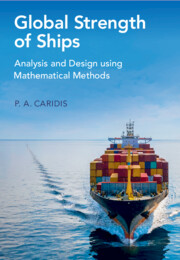Book contents
- Global Strength of Ships
- Reviews
- Global Strength of Ships
- Copyright page
- Dedication
- Contents
- Preface
- Abbreviations
- 1 Ship Structures and Structural Design Practice
- 2 The Evolution of Ship Structures from Antiquity to the Present Day
- 3 Sea Loads on Ship Structures
- 4 Primary Loading of Ship Structures
- 5 Hull Structure, Mechanical Equipment and Cargo-Related Loads
- 6 Linear Response to Primary Loading
- 7 Nonlinear Response to Primary Loading
- 8 Hull Girder Vibration
- 9 Probabilistic Modelling of Primary Loading and Hull Girder Response
- 10 Design of Hull Girder for Strength
- 11 Aspects of Uncertainty
- 12 Ship Structural Reliability Theory and Applications
- 13 Hull Girder Strength Assessment Using the Finite Element Method
- 14 Optimum Design of Ship Structures
- Book part
- Index
- References
3 - Sea Loads on Ship Structures
Published online by Cambridge University Press: 20 March 2025
- Global Strength of Ships
- Reviews
- Global Strength of Ships
- Copyright page
- Dedication
- Contents
- Preface
- Abbreviations
- 1 Ship Structures and Structural Design Practice
- 2 The Evolution of Ship Structures from Antiquity to the Present Day
- 3 Sea Loads on Ship Structures
- 4 Primary Loading of Ship Structures
- 5 Hull Structure, Mechanical Equipment and Cargo-Related Loads
- 6 Linear Response to Primary Loading
- 7 Nonlinear Response to Primary Loading
- 8 Hull Girder Vibration
- 9 Probabilistic Modelling of Primary Loading and Hull Girder Response
- 10 Design of Hull Girder for Strength
- 11 Aspects of Uncertainty
- 12 Ship Structural Reliability Theory and Applications
- 13 Hull Girder Strength Assessment Using the Finite Element Method
- 14 Optimum Design of Ship Structures
- Book part
- Index
- References
Summary
Chapter 3 provides an introduction to the sea loads that act on ship structures, focusing on environment-related and transient loads. A hypothetical but realistic scenario of a loaded voyage of a bulk carrier is presented, and is used to identify and subsequently classify all loads that act on the hull girder. These are classified as environment-related, hull girder-related, mechanical equipment-related and cargo-related. The sources of environment-related loads are then discussed. These include hydrostatic pressure, wave loads, thermal gradients, ice loads, wind pressure and related variations on a geographic and temporal basis. Transient wave loads are then discussed (bottom slamming, bow flare impact and deck wetting), followed by a discussion on springing. The discussion of slamming includes hydroelastic effects. The need for nonlinear analysis in estimating springing and whipping loads is discussed in the last section of the chapter.
Keywords
- Type
- Chapter
- Information
- Global Strength of ShipsAnalysis and Design using Mathematical Methods, pp. 89 - 121Publisher: Cambridge University PressPrint publication year: 2025

